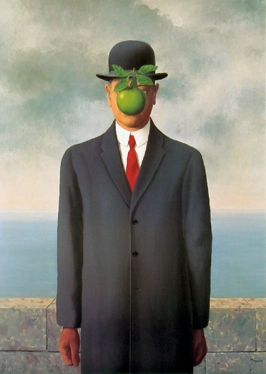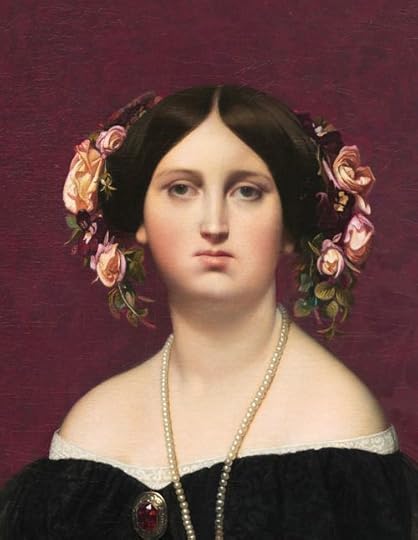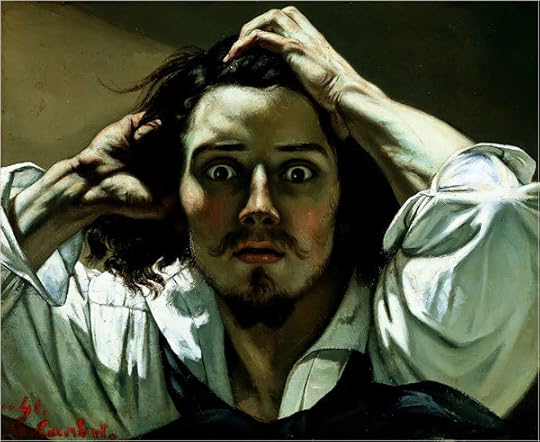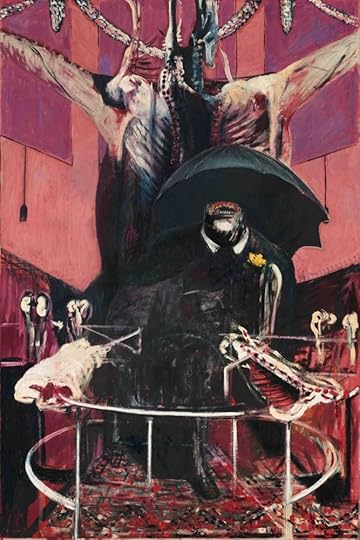Art Lovers discussion
Psychology of Art
>
What was this artist thinking when he or she made this?
date newest »
newest »
 newest »
newest »
 ok I'll start.
ok I'll start.
The Listening Room
Rene Magritte
1952
I have this coffee table book of a lot of Magritte's art. This is when I first saw this painting. At that point in my life, I wasn't doing well emotionally and felt 'trapped' inside my own body, my mind especially. Also, trapped inside life. So this picture really resonated with me. I look at the apple hopelessly enclosed inside those walls. There is no possible way for it to get out that window, it is trapped. Not that an apple is human in any way, but that is exactly how I felt.
I have heard someone quote Margritte saying that his art doesn't mean anything, but I've also read others dissecting the reason for this painting or that.
I really have no idea what he was thinking when he painted it. I don't know as much about his life as I would like. The name of the painting "The Listening Room". What does that mean? It didn't quite fit with my impressions of the work. So what did he mean even by the title?
I looked up a few sites that explain a little bit about this work in particular.
Speaking of the apple itself: The ambiguity of its role in the present scene invites the viewer to contemplate possible interpretations without ever offering a definitive meaning, sustaining a sense of enigma that the painter prized above all else. "
This is exactly what it did for me. And maybe by the picture of the,apple in a room meant nothing to him but the point of the painting is to aide the viewer to think for his or her self.
The painter stated: "Those of my pictures that show very familiar objects, an apple, for example, pose questions. We no longer understand when we look at an apple; its mysterious quality has thus been evoked. In a recent painting, I have shown an apple in front of a person's face At least it partially hides the face. Well then, here we have the apparent visible, the apple, hiding the hidden visible, the person's face. This process occurs endlessly. Each thing we see hides another, we always want to see what is being hidden by what we see. There is an interest in what is hidden and what the visible does not show us. This interest can take the form of a fairly intense feeling, a kind of contest, I could say, between the hidden visible and apparent visible".
http://www.renemagritte.org/the-liste...
Here he does state the rationale behind most or all of his works. The picture itself makes more sense to me in his point of view or intention. But he uses the words "a fairly intense feeling which is exactly what it did for me.
But I didn't quite see it as wanting to see the 'hidden', it was more the whole concept of the apple trapped in the room mirroring my own feelings at the time.
Another quote found in the above site:
"By means of the interference of conceptual paradox, he causes ordinary phenomena to inherit extraordinary and improbably conclusions. What happens in Magritte's paintings is, roughly speaking, the opposite of what the trained mind is accustomed to expect. His pictures disturb the elaborate compromise that exists between the mind and life. In Magritte's paintings, the world's haphazard state of consciousness is transformed into a single will"
 Interesting choice and commentary/quotes, Heather! I guess the aspect of the paradox strikes me first as it is completely unreal and does not fit into any actual experience I have had. However, by changing the scale of things one could place an apple in a dollhouse and achieve the very same effect. As I kept looking at the image the concept that rose to the surface of my mind was the conflict between nature and industrialization. I now see nature trapped within the cage of mankind. The apple belongs outside of the room connected to its origins (not in the artificial environment of a room). Perhaps that is a simplistic interpretation, but I suspect it reveals a bit more about myself than the artist. Can one really know the intent of the artist by looking at the art (especially modern art)? Besides, can one not view "The Listening Room" (1952) as a precursor and companion to "The Son of Man" (1964)?
Interesting choice and commentary/quotes, Heather! I guess the aspect of the paradox strikes me first as it is completely unreal and does not fit into any actual experience I have had. However, by changing the scale of things one could place an apple in a dollhouse and achieve the very same effect. As I kept looking at the image the concept that rose to the surface of my mind was the conflict between nature and industrialization. I now see nature trapped within the cage of mankind. The apple belongs outside of the room connected to its origins (not in the artificial environment of a room). Perhaps that is a simplistic interpretation, but I suspect it reveals a bit more about myself than the artist. Can one really know the intent of the artist by looking at the art (especially modern art)? Besides, can one not view "The Listening Room" (1952) as a precursor and companion to "The Son of Man" (1964)? The Son of Man
Rene Magritte
1964

Magritte:
"At least it hides the face partly well, so you have the apparent face, the apple, hiding the visible but hidden, the face of the person. It's something that happens constantly. Everything we see hides another thing, we always want to see what is hidden by what we see. There is an interest in that which is hidden and which the visible does not show us. This interest can take the form of a quite intense feeling, a sort of conflict, one might say, between the visible that is hidden and the visible that is present."
In contrast to my own perspective Magritte seems to be focused on what is visible versus hidden within the painting.....
 Luís wrote: "The Two Sisters
Luís wrote: "The Two SistersTheodore Chasseriau
Completion Date: 1843
Romanticism
Luis, so what do you think the artist's intent was to paint his sisters? Was it because he was so close to them? Were they just subjects to combine the works of Ingres and Delacroix to bring to pass his own style? Or did he have a hidden agenda? In your opinion.
 Haaze wrote: "Interesting choice and commentary/quotes, Heather! I guess the aspect of the paradox strikes me first as it is completely unreal and does not fit into any actual experience I have had. However, by ..."
Haaze wrote: "Interesting choice and commentary/quotes, Heather! I guess the aspect of the paradox strikes me first as it is completely unreal and does not fit into any actual experience I have had. However, by ..."In the quote you stated and in the parts I read about the mentality of Magritte in his paintings, he states that we want to see the hidden behind what it is that we can see. So he means what does the man look like? His nose, his eyes, etc.? My interpretation also, which may not be what Magritte was intending, was, thinking psychologically again, what is in the man's mind? That is hidden and maybe we want to know that hidden aspect in addition to, or instead of just the outside features of his face.
 And Haaze, when you said your first impression was that it is completely unreal, maybe this is why he is a surrealist artist... ;)
And Haaze, when you said your first impression was that it is completely unreal, maybe this is why he is a surrealist artist... ;)
 Heather wrote: "And Haaze, when you said your first impression was that it is completely unreal, maybe this is why he is a surrealist artist... ;)"
Heather wrote: "And Haaze, when you said your first impression was that it is completely unreal, maybe this is why he is a surrealist artist... ;)"Ha ha ! True, but it could be a real apple inside a real dollhouse and then it is no longer surrealism. Just being the devil's advocate.....
 Heather wrote: "My interpretation also, which may not be what Magritte was intending, was, thinking psychologically again, what is in the man's mind? That is hidden and maybe we want to know that hidden aspect in addition to, or instead of just the outside features of his face."
Heather wrote: "My interpretation also, which may not be what Magritte was intending, was, thinking psychologically again, what is in the man's mind? That is hidden and maybe we want to know that hidden aspect in addition to, or instead of just the outside features of his face."We perceive things so differently. Art is fascinating in that way. I see an anonymous man blending into a society that is becoming homogenous. The loss of self and identity in the whirlpool of billions of people. Magritte's views of the visible and hidden are certainly different aspects of the painting.
 Haaze wrote: "Heather wrote: "And Haaze, when you said your first impression was that it is completely unreal, maybe this is why he is a surrealist artist... ;)"
Haaze wrote: "Heather wrote: "And Haaze, when you said your first impression was that it is completely unreal, maybe this is why he is a surrealist artist... ;)"Ha ha ! True, but it could be a real apple insid..."
"like"
 Luís wrote: "The Two Sisters
Luís wrote: "The Two SistersTheodore Chasseriau
Completion Date: 1843
Romanticism
"
Hmm, I see a wonderful and seemingly realistic portrait of two sisters. What is the artist thinking about? I sense that the artist is working towards completing the work so he can cash in (to pay the bills) and/or to schmooze with the sisters/upper class families to further his reputation. Am I missing something here? The portrait is not clashing with the standards of the 1840s, right? However, I know nothing about Chasseriau's life at this point.
I am surprised (considering the suggested amorous quality) that Chasseriau painted the sisters with such apprehensive faces. In my eyes they don't seem to be close to the artist. In contrast they appear quite serious. What are your thoughts?
 Interesting observation, Haaze. The only thing I see that you noted is the expression on their faces. It is bland compared to the various expressions on the portraits made by Ingres. The one sister does look apprehensive while the other looks like she holds some sort of secret, as in she has a 'knowing' look on her face. As for looking serious, this, I think, (anyone care to confirm my suspicions?) is typical of the period. They don't seem to be close to the artist, more as if obligated to pose for him.
Interesting observation, Haaze. The only thing I see that you noted is the expression on their faces. It is bland compared to the various expressions on the portraits made by Ingres. The one sister does look apprehensive while the other looks like she holds some sort of secret, as in she has a 'knowing' look on her face. As for looking serious, this, I think, (anyone care to confirm my suspicions?) is typical of the period. They don't seem to be close to the artist, more as if obligated to pose for him. But I did find this portrait by Ingres in contrast to the expressions on his other works, where the sitter obviously looks bored or just disgusted with the whole thing. What do you think?

Madame Moitessier
Jean Auguste Dominique Ingres
1851
 Looking at portraits makes me wonder about the final interactions between artist and the "consumer"? Did conflict arise in terms of customer satisfaction. I agree with your observation, Heather, in terms of her looking a bit blasé. The hours spent at the artist's mercy must have been numerous.
Looking at portraits makes me wonder about the final interactions between artist and the "consumer"? Did conflict arise in terms of customer satisfaction. I agree with your observation, Heather, in terms of her looking a bit blasé. The hours spent at the artist's mercy must have been numerous. What about this self-portrait? What was the artist thinking bringing this facial expression to a self-portrait ?
The Desperate Man (self-portrait)
Gustave Courbet
1843-45

 Haaze wrote: "Looking at portraits makes me wonder about the final interactions between artist and the "consumer"? Did conflict arise in terms of customer satisfaction. I agree with your observation, Heather, in..."
Haaze wrote: "Looking at portraits makes me wonder about the final interactions between artist and the "consumer"? Did conflict arise in terms of customer satisfaction. I agree with your observation, Heather, in..."wow, I've never seen that one. He kind of looks like Johnny Depp in Pirates of the Caribbean. I mean, really!
But I have no Idea what he was thinking! And how would he hold that face for long enough to paint it?
He does look like he's literally going to pull his hair out! Yes, desperate man, appropriate name.
 You can probably surmise that I’m going back through older folders and threads and trying to resurrect some discourse.
You can probably surmise that I’m going back through older folders and threads and trying to resurrect some discourse.This one was fun. I’m not at my PC right now so I can’t post a picture to refer to but does anyone have a favorite painting, or maybe not ‘favorite’ but one that makes you ponder?
Have you ever asked yourself what the artist was thinking when he or she was doing that?
I’d love your examples! I did mine above but oh, I have more!
 This is my next piece. I have a word or two to say about this but as I found this painting, I found an article on Francis Bacon that I want to read. So I'll post this here:
This is my next piece. I have a word or two to say about this but as I found this painting, I found an article on Francis Bacon that I want to read. So I'll post this here:
Painting 1946
Francis Bacon
Does anyone have any thoughts on what you think Bacon was thinking when he painted this?
 (New to group lmk if I'm doing something wrong with the reply format) But woah, I haven't really been struck by a painting for a while but the abstract+carnal quality of this really did. It seems like a stream of consciousness painting so I'd figure he's only really somewhat "thinking" in a logical sense and more just painting what comes to mind. The goriness is contrasted by the umbrella, detailed carpet, seemingly formal attire, and a kind of minimalist modern backdrop, so maybe what was going through his mind was a bridge-building between the modern, civilized, industrial world to death, guts, nature, giving them both an equally dark representation. The way the corpse is suspended also evokes crucifixion but at the same time a slaughterhouse, meat industry vibe, once again building a bridge, religion, industry, carnality. Possibly a bit nihilistic but I think its abstract quality is intriguing. Looking forward to your thoughts :)
(New to group lmk if I'm doing something wrong with the reply format) But woah, I haven't really been struck by a painting for a while but the abstract+carnal quality of this really did. It seems like a stream of consciousness painting so I'd figure he's only really somewhat "thinking" in a logical sense and more just painting what comes to mind. The goriness is contrasted by the umbrella, detailed carpet, seemingly formal attire, and a kind of minimalist modern backdrop, so maybe what was going through his mind was a bridge-building between the modern, civilized, industrial world to death, guts, nature, giving them both an equally dark representation. The way the corpse is suspended also evokes crucifixion but at the same time a slaughterhouse, meat industry vibe, once again building a bridge, religion, industry, carnality. Possibly a bit nihilistic but I think its abstract quality is intriguing. Looking forward to your thoughts :)
 His work is spooky and macabre, not necessarily a bad thing. This painting makes me think of the of the scene in the first Batman movie where the Joker and his gang vandalize an art gallery, and during their escapade of destroying everything, they come across a very Bacon-esque looking piece, and as one of his cronies was about to destroy it, the Joker says "No, I kinda like this one, Bob"
His work is spooky and macabre, not necessarily a bad thing. This painting makes me think of the of the scene in the first Batman movie where the Joker and his gang vandalize an art gallery, and during their escapade of destroying everything, they come across a very Bacon-esque looking piece, and as one of his cronies was about to destroy it, the Joker says "No, I kinda like this one, Bob"https://youtu.be/1oi_3qy1si4?t=2m42s
 Ant wrote: "(New to group lmk if I'm doing something wrong with the reply format) But woah, I haven't really been struck by a painting for a while but the abstract+carnal quality of this really did. It seems l..."
Ant wrote: "(New to group lmk if I'm doing something wrong with the reply format) But woah, I haven't really been struck by a painting for a while but the abstract+carnal quality of this really did. It seems l..."Great answer, Ant! Welcome to the group and I'm so glad you just jumped right in and added a comment. Thank you for that detailed comment, too!
You mentioned "stream of consciousness". Right, totally! That's kind of what it looks like to me, where were his thoughts going when he painted this? I enjoyed what you had to say about the bridge between civilization and death, guts, etc.
Going along the same train of thought, I see what looks like a vulture, dressed up in a fancy suit, maybe a tuxedo, with an umbrella behind him. He may represent corporations. Or wealth, or power. But he feeds and preys off of the refuse around him. The umbrella is separating him from the death that his power overtaking left behind.
It is a thought provoking piece, that's for sure. I don't think Bacon was religious at all, that I know of. I do think he drank a lot.
 Brianna wrote: "His work is spooky and macabre, not necessarily a bad thing. This painting makes me think of the of the scene in the first Batman movie where the Joker and his gang vandalize an art gallery, and du..."
Brianna wrote: "His work is spooky and macabre, not necessarily a bad thing. This painting makes me think of the of the scene in the first Batman movie where the Joker and his gang vandalize an art gallery, and du..."I hadn't seen that movie, Brianna, thank you for posting that link to that part. It is a Bacon piece that he 'kinda likes'. lol Awesome!




Feel free to post examples of different artists or works that come to your mind whom you can use to illustrate your point.